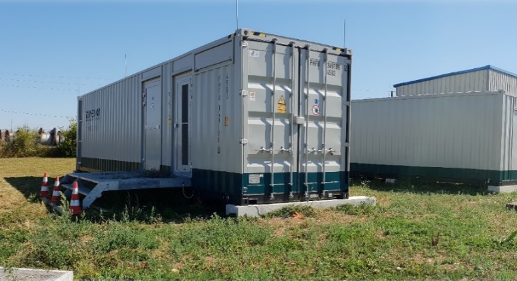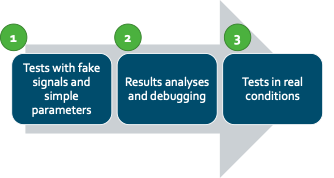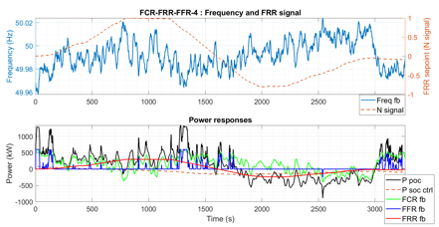EU-SysFlex French Virtual Plant: Multi-services provision by storage successfully demonstrated through local tests
28.12.2020NewsA “multi-resource multi-service” VPP
Based on an innovative approach of ‘multi-services provision by multi-resources’, a Virtual Power Plant (VPP) composed of renewables and storage was proposed in the Work Package 8 (WP8) demonstration of EU-SysFlex project by EDF and ENERCON. In this demonstration, several distributed resources are controlled in a coordinated manner to provide multiple services and flexibility products to the power system. The portfolio of resources comprises a 12-MW wind farm connected to the French distribution grid of the “Marne” Department as well as a full storage system of 2 MW / 2.9 MWh, photovoltaic panels and a variable load test bench, which are installed at EDF Concept Grid testing site south-east of Paris.
Composed of a 45-foot container containing a lithium-ion battery and a 40-foot container containing the energy conversion system, the ENERCON storage system was commissioned at Concept Grid in January 2020 (Figure 1).

Successful trials of “multi-service” provision by the storage system
Before demonstrating the full-chain operation of the whole VPP, it is essential to first test and to verify the individual services provision by each controllable resource within the VPP. Therefore, the WP8 team started by carrying out several local tests on the storage system by activating different services through the real-time storage controller E-SCU. These tests were performed locally as a first step without interactions with the top layers of the centralized Energy Management System (EMS) of the VPP comprising the optimization process.
Thanks to the local tests management interface developed on a real-time simulation platform, the storage system was controlled to provide several services to the grid, such as:
- Fast Frequency Response (FFR), which refers to the enhanced frequency scheme that can be triggered within 1 second and is generally used to tackle the frequency control challenges in a system with low inertia.
- Frequency Containment Reserve (FCR), which corresponds to the active power output changes in response to a change in system frequency, in such a way that it assists with the recovery to target frequency, as specified in the European network code ‘Requirement for Generators’ (RfG).
- Frequency Restoration Reserve (FRR), which means the active power reserves available to restore system frequency to the nominal frequency and, for a synchronous area consisting of more than one load-frequency control area, to restore power balance to the scheduled value. In France, this service is activated in practice by following a FRR signal calculated and sent directly by the transmission system operator.
- Ramp Rate Control (RRC), which is the ramp smoothing of the overall production of the VPP by using the storage to reduce the variability of renewable generation.
These services procured from the storage and tested locally are well aligned with the power system scarcities at high RES penetration rates, identified in WP2 and in WP3 of the EU-SysFlex project, in terms of future needs of ancillary services and flexibilities.
In order to ensure the safety of the materials and to facilitate troubleshooting, the field testing has been conducted by following several steps, in particular (Figure 2):
- the preparation of the test platform built on a real-time simulator;
- the verification tests based on fake signals and simplified parameters of the storage E-SCU controller
- the tests of full storage services in real conditions as well as the post-processing and analyses of experimental

All the services were first tested separately in order to validate the good operation of the corresponding control algorithms, then also simultaneously, to verify the technical capacity of the storage system to provide “multi-services” to the power system when needed. In the example given in Figure 3, all 3 frequency reserves (FFR, FCR and FRR) were allocated on the storage and delivered correctly according to the grid frequency and to the FRR activation signal applied. Moreover, it was demonstrated that through appropriate controller design and signals measurement, the performance of each service provided can be assessed individually while different services were simultaneously activated.

During this phase of local tests on storage, the obtained experimental results were very satisfactory and showed good performance of various services offered by the storage system within the French VPP, compared to the requirements that would be demanded by system operators.
Next steps
Following the successful experimentations on the storage system, the WP8 team is carrying out local tests of the wind services at the Anglure wind farm by applying a similar approach. The next target will be to fully implement and commission the whole ICT (Information & Communication Technology) infrastructure of the VPP, allowing a remote control of the wind farm as well as the operation of the full-chain VPP.
Written by: Dr. Ye Wang, EDF, WP8 leader of the EU-SysFlex project.
EDF is the largest producer of renewable electricity in Europe. Two priorities are at the heart of its research: preparing the flexible and adaptable electrical systems and grids of tomorrow, and consolidating and developing competitive and low-carbon energy generation mixes.
Disclaimer: blog entries reflect individual views of the author(s) that may not reflect official positions or communication of the project / project consortium.